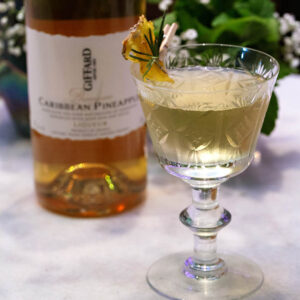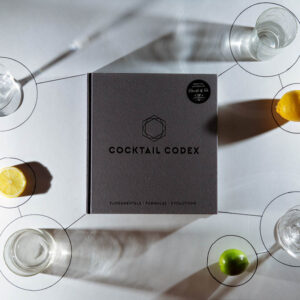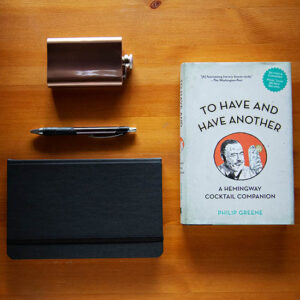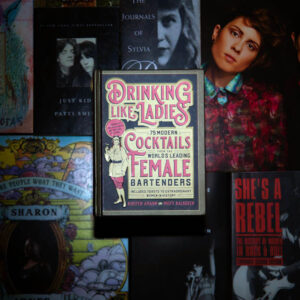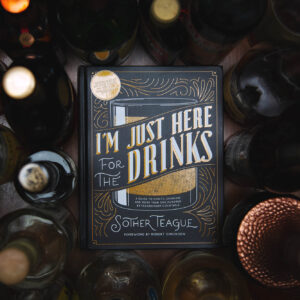About a year ago, we here at Bartender Atlas were approached by our pal Adam McDowell to start a regular feature on the site called The Boozy Bookshelf. The premise for the series was to profile essential reads for people with a keen or professional interest in adult beverages. Life changes with Adam meant that he was no longer able to do the series so we tried to keep it up. As we get busier with running the site and planning for what is going to be an awesome 2018, we approached our friends Marlene and Lucas at Famous Last Words Bar in Toronto to see if they were interested in taking over the series. Famous Last Words is a book themed bar so it only made sense that we partner up on this and we are so happy that they said yes! So with that, here is Famous Last Words’ first installment of The Boozy Bookshelf with Jim Meehan’s new book, Meehan’s Bartender Manual.
.jpg)
Marlene’s Review:
I quite liked this book, despite not being able to figure out who, exactly, it was written for. Maybe that’s because it sort of feels like two separate books: “How To Open A Bar – A Million Things You’ve Never Even Considered” and “Behind the Stick – Tips, Tricks and Hacks to Make You The Best Bartender You Can Be”.
Ranging so widely across such a vast array of topics has its upside: what it occasionally lacks in profundity, it makes up for in accessibility and thoroughness. In his introduction, Meehan says that the book is about “bartending itself”, and who am I to argue with him? Clearly his years of experience and his incredible successes in the biz entitle him to define what bartending means to him. And there’s no denying that a lot of ground is trod in the almost 500 pages: from where to open a new bar, through tools and techniques, encompassing 100 recipes, and finishing on hospitality and “life beyond”, there will undoubtedly be something for everyone who makes his or her living from providing alcoholic beverages – and a place in which to imbibe them – to paying guests.
One thing I genuinely appreciated about this book is that the balance is tilted more towards practical information and less to vague platitudes than many of the (admittedly limited in number) “bar books” I’ve read. But the issue with granularity is that some of it is helpful (where was this when I was agonizing about the right amount of overhang for the bartop at flw?) and some less so (20+ pages on building an elaborate round of 11 cocktails so they come out all at once feels like overkill). Of course, to another reader the exact opposite may be true. So kudos to Jim for not simply telling us that knee room is important to guests and that they enjoy getting all of their round of drinks at once. On the “How to Open a Bar” side of things, there’s enough food for thought on topics like branding and bar design to get you started – but it’s not going to make the need for a professional graphic designer or an experienced architect obsolete. But if you’re looking to open a cocktail bar from scratch, this section will resonate.
When it comes to recipes (and heaven forfend we should have a bartending book without the requisite recipes!), he provides a decent amount of history and background on the spirits before launching into individual specs. The structure is pretty helpful: manageable chunks of info on “origin”, “logic” and “hacks”; the main frustration here for me (as is always the case with American books) is that many reference ingredients and brands that are nearly impossible to source in Canada.
A few bon mots in the final section on hospitality (“We’re here to serve our guests’ interest, not to
venerate the platonic ideal of mixology” and “strive for excellence, not perfection”) may not be earth-shattering in their originality, but they definitely serve as good reminders for anyone in the business. It’s those chapters that will echo long after you’ve forgotten where in the round you should be making the Irish coffee (hint: it’s last). Hopefully anyone less interested in choosing a location and where to put the drink wells will stick through until the end.
Marlene’s Last Word: Meehan scratches the surface of a good many topics; it’s a must-read for anyone opening a bar (although it may leave you wanting more), and a helpful resource for any serious bartender.
Lucas’s Review:
To avoid burying the lede, I should start by saying this: Meehan’s Bartender Manual is an incredible work of passion, experience, and knowledge that has the chance to raise the floor of the minimum level of quality for new cocktail bars while offering great nuggets of advice for bartenders of all levels. It also has the snazzy production values now expected in major bar books published during the recent renaissance. Mr. Meehan writes with a clean and engaging (if a bit humorless and dry) style, and Mr. Gild’s photography and Mr. Magnami’s illustrations are uniformly sharp, accurate, and gorgeous.
Meehan’s Bartender Manual is the most ambitious bartending and cocktail book to be released in years. With that ambition comes a few problems — while I am trying not to judge the book on my expectations, it spends a lot of its hefty 470+ pages covering ground that has been covered elsewhere, including Mr. Meehan’s own PDT Cocktail Manual. In reviewing it as a one-stop-shop for any bartender, I think it might overreach a bit into bar construction and management practices for bartenders, particularly non-cocktail bartenders or ones new to the profession. Rather than being a bartender’s manual, the book strikes me more as a bar owner’s or cocktail bar manager’s manual — and it should become essential for those roles.
If I were to run a series of university courses on running a cocktail bar, Morganthaler’s The Bar Book would be the textbook for Bartending 101 — it is concise, clear, easily referenceable, and teaches, with simplicity and aplomb, techniques like shaking, stirring, and making ingredients like syrups and simple infusions. Some of the best parts of Meehan’s Bartender Manual cover areas the Bar Book lack — the later chapters on steps of service and hospitality are tremendously useful for a new bartender or a manager, respectively. Liquid Intelligence would be the textbook for Advanced Drink Making, and Meehan wisely avoids putting too much focus on the science end of things beyond lengthy discussions of spirits production. That ultimately positions The Bar Book as the textbook for Bar-Running 101, and the layout of the book actually strikes me as reminiscent of that purpose, with sidebars containing clever asides from hospitality and spirits industry and smart, clean illustrations by Gianmarco Magnani.
Where the book really stands out are the chapters and asides that I haven’t seen anywhere else: the chapters on bar design, service, and hospitality. The bar design chapter is particularly brilliant, if strangely positioned for a “Bartender’s” manual. The illustrations of layouts are a fantastic inclusion, though I wonder why they did not pair them with actual photos of the locations rather than the (admittedly attractive and likely accurate) illustrations of the bar. My only caveat is that the Bar Design chapter is a lot of information to frontload and the book may have better been served by putting service and hospitality discussions earlier, as those concepts are more useful to all bartenders and would ease the reader into Meehan’s overall mindset. The latter chapters are brilliant, refining and making practical what makes books like Setting the Table useful. I honestly wish Mr. Meehan had written an entire book covering only hospitality, service, and bar management, but commercial considerations would probably prevent that. My only issue is that so much of it feels like anecdote and rumination — while beyond the scope of a book like the Bartender’s Manual, I would love to see some actually researched discussions of the psychology behind certain elements of layout and service. That said, while cocktail bartenders are embracing rotovaps and university lab equipment, I get that we’re not exactly scientists.
The core of the book is the Spirits and Cocktail section, and it strikes me as a bit odd and almost out of place. While he does foreshadow the cocktails in his instructions on how bartenders might split a complicated order, and references it in his chapter on construction cocktail menus, it feels almost like a completely separate book — and at 250 (!!!) pages, it essentially is. While his spirits knowledge is well-researched and avoids the commercial myths that sometimes pop up in books of cocktail menus, it is pretty readily available elsewhere. The cocktail list itself is well thought-out, with a nice mix of spirits and additives, and a great selection of classics and originals. The latter stand out by how well they fit in with the classics. The “Origin/Logic/Hacks” makes the list slightly more functional than classic Savoy-style manuals or even more modern drink books like PDT or Dead Rabbit. Most striking is the photography; brightly colored and beautifully lit and composed, the cocktail photos are as gorgeous as any I’ve seen and could serve as a lovely draw for any casual bar enthusiast flipping through the massive tome in a store.
Ultimately, I wonder if the need to sell a book to as large an audience as possible has led to these feelings of the book being a bit unwieldy and divided. The sections on how to build a home bar and the lavishly illustrated cocktail list seem at odds to the more managerial focus of the rest of the book. However, those are what will probably sell to cocktail enthusiasts, and this is a book that deserves a wide industry audience.
Lucas’s Last Word: Meehan’s Bartender Manual hasn’t displaced Morganthaler’s The Bar Book as the first book a new bartender should own, but it will be the first thing I hand to anyone looking to start their own bar or cocktail program. It’s easily the most important bar book to appear in the last three years. It is a book that needed to exist and that every cocktail bartender should at least peruse; it will benefit the whole of cocktail culture tremendously.









